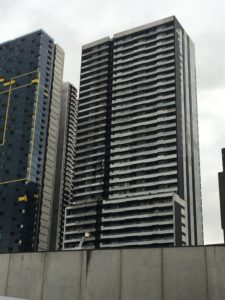Are you up-to-date on the recent events and changes regarding combustible cladding?
In recent months, several changes to guides and protocols a related to combustible cladding have occurred. A brief description of these changes are provided below.
The fire at the Neo200 tower on Spencer Street, Melbourne, has highlighted ongoing concerns about combustible cladding on buildings. Thankfully, this fire resulted in no fatalities, however th injuries were reported. The fire also led to major disruptions within the Melbourne CBD.
Various levels of government and industry have been responding to this ongoing fire safety issue through changes to both legislative and products, respectively. Rectification works on some affected buildings have also commenced.
In February, the Engineers Australia Society of Fire Safety published Practice Guide Façade/External Wall Fire Safety Design. The guide serves as a benchmark for performing fire safety assessments, in particular for existing buildings. The guide provides a method to follow, outlines aspects to consider, information on test methods, and encourages a nationally consistent approach. It can be downloaded from the publications section of SFS webpage. CSIRO is proud to be a contributor to the work and encourages the application of the guide and welcomes related feedback.
The “Insurance industry aluminium composite panel and other combustible facade materials, residual hazard identification/reporting protocol” was updated on 2 July 2019 by the ICA, FPAA and IE. The main change made to the protocol is the removal of compressed phenolic from Category D. Phenolic compounds are a major component of High Pressure Laminates (HPL) which are a cladding type which, while rarely installed, are present in the Australian market. The UK government has recently published Advice Note 22 for owners of residential buildings with HPL cladding that provides information on these types of materials.
Additionally, due to changes made to the protocol, it is recommended that recipients of material analysis reports in the second half of 2018 verify whether the results meet the current requirements. Specifically, Category B was previously changed to permit 34-38% organic polymer content, but has since reverted in the latest revision of the protocol to the original specification. It is therefore recommended that report recipients review assessment whether any advice provided, or decisions made, based on the categorisations included in those reports remains valid.
On the 22 July 2019, the ABCB released an Advisory Note on the intent of the timber framing concessions in Specification C1.1 of the National Construction Code (NCC).
Interflam2019 conference, one of the leading international fire science and engineering conferences, was held in London in early July, with combustible cladding the keynote topic. The papers on the combustible cladding topics are likely to be compiled in a Fire and Materials Journal Special Topics edition. Alex Webb, CSIRO, presented a paper on the regulatory changes and testing Standards across three countries. He also presented at the 2nd Annual Fire Safety and Cladding Summit, in Melbourne. The subsequent conference panel discussion focused on Australian issues, particularly the LaCrosse fire and related legal decisions, as well as the implications of the well-publicised professional indemnity insurance changes for fire safety practitioners.
The University of Queensland has made public the Material library of cladding materials. The objective of the library is to provide the data necessary for a competent fire safety engineer to conduct the analysis required to determine the safety of a façade system. The Queensland Government Safer Buildings Phase 2 assessments deadline is 31 July 2019.
The Victorian State Government announcement of $600 million in funding towards rectification and the creation of Cladding Safety Victoria is a major step towards a solution for building owners.


